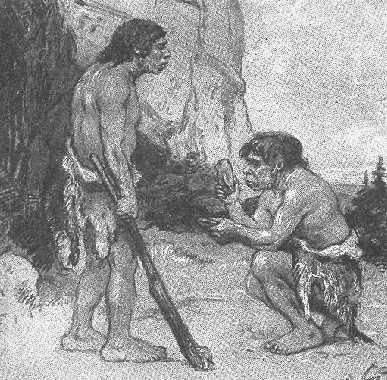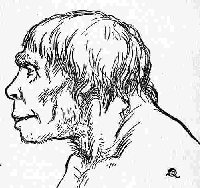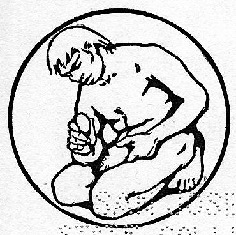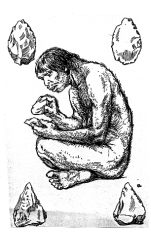|
|
|---|
THE NEANDERTHALS: --- 40,000 BC

Did the Neanderthals make use of Medical Marihuana?
The thought of having a medicine that was in use long before the first humans had even walked on this planet is interesting indeed; one might say it is the stuff of science fiction writers. But unfortunately, while many web sites "hint" at the possibility, there is no solid evidence that the Neanderthals made any use of Cannabis for medical purposes. On the other hand, there is no solid evidence that they didn't either.
 The big problem is that there is a total lack of solid archeological evidence, one way or the other, on the subject. For example, no less than seven different plant pollens were found at one well-known Neanderthal gravesite in northern Iraq. Because at least one of these plants had medicinal uses, this finding has raised much speculation. Was this proof that the Neanderthals made use of medical herbs? And what about the other plant pollens found there, was Cannabis one of them?
The big problem is that there is a total lack of solid archeological evidence, one way or the other, on the subject. For example, no less than seven different plant pollens were found at one well-known Neanderthal gravesite in northern Iraq. Because at least one of these plants had medicinal uses, this finding has raised much speculation. Was this proof that the Neanderthals made use of medical herbs? And what about the other plant pollens found there, was Cannabis one of them?
After extensive research as well as contacting various Neanderthal experts, the answer seems to be that no one really knows. At the present time we simply don't posses the scientific testing methods to find out exactly what those other pollens were, and so it's anyone's guess.
Thus, the debate goes on, and while numerous individuals (many of good standing) believe that they did, most Neanderthal experts have chosen to remain silent on the subject and simply wait for more archeological evidence, one way or the other, to be found.
TAKEN FROM THE BOOK - The Shanidar Neanderthals by Erik Trinkaus
Various sources of information about Neanderthal (men/women) were located. The following quotation from the book. "Neanderthal Man by Myra Shackley (1980) perhaps summarizes them all: "The archaeology of Shanidar cave suggests that the Neanderthals had more than a passing knowledge of the medicinal properties of plants. . . . [With Reference to a male Skeleton] . . . The man had been buried in a grave hollowed out among the rocks and covered over with earth from the living floor of the cave. Detailed and precise pollen analysis of the grave soil and surrounding levels showed that the body had been laid to rest on a bed of brightly-coloured flowers, probably woven into wreaths with a pine-like shrub. . . . The pollen of at least eight species was represented, mostly small brightly-coloured wild flowers, relatives of the modern grape-hyacinths, batchelor's buttons and groundsel, which had been woven into the branches of the pine-like shrub. Other (control) samples contained traces of windblown pollen but in the samples associated with [the body] pollen from particular species occurred in clusters of tens and hundreds, which was no accident of nature or sample contamination. In addition some of the pollen grains seemed to be resting inside the anther (pollen-bearing part of the flower) suggesting that the flower itself had been present, not just the blown pollen. The following genera were represented:
Pollen from two other species also occurred but could not be identified. The Compositae are the daisy family, and at least six species of the genus Achillea are found today in the Shanidar area, including yarrow or milfoil which is used in herbal medicines and for application to wounds. Centaurea solstitialis is also used for the same purpose as well as being eaten, and is a striking plant with white leaves and rounded heads of pale-yellow flowers. Of the groundsels Senecio vernalis occurs near the site and has big bright-yellow flowers. It is also used as a wound poultice. The species of Ephedra has flowers which are not so conspicuous but whose branches could be woven together to make a bed or wreaths. The hollyhock pollen occurred as isolated grains, not clusters, but was very abundant. Its roots, leaves and flowers make a whole range of medicines to relieve everything from toothache to spasms, and it has been described as the poor man's aspirin. It seems most unlikely that Neanderthal man was unaware of the medicinal properties of these plants and very possible that the charming idea of burying the dead with flowers was accompanied by some deeper motive, perhaps wishes for its re-birth by applying known remedies for sickness."


The Neanderthals Made Stone Tools and had the Same Bone Structure as Ourselves
WERE THE NEANDERTHALS HUMAN?
Again, the big problem is that there is a total lack of solid archeological evidence, one way or the other, on the subject. Here are the facts as we see them:
- BONES STRUCTURE: The Neanderthals share the same bone structure (bone for bone) as modern day humans, differing only in relative sizing. But on the other hand, there is a monkey around today (forgot exactly which one) that also shares our bone structure with humans, so this may or not mean anything.
- TOOLS: Archeological evidence clearly indicates that Neanderthals made stone tools/implements. This of-and-by-itself implies that they had some level of intelligence (something usually associated only with humans).
- HUMAN TRAITS: We know that they lived in small family groups, conducted burials and even assisted members who were elderly or were not capable of fending for themselves. [show me one other animal that does that]
- INTERBREEDING: Archeologists have even found at least one babies body that seems to be a hybrid Neanderthal/Cro-Magnon, implying crossbreeding took place. Something that could only have happened if all of us were of one species. However, it should be stated that there is some dispute among archeologists about this matter.
- DNA EVIDENCE: So far there has only been one short study done on Neanderthal DNA. The results showed that we were two different spices, however it later came out that the results could be interpreted as meaning anything. According to the National Geographic [Oct 2008] - "We know that the human and chimpanzee sequences are 98.7% the same, and Neanderthals are closer to us than chips"
But in any-case (human or not), HOW DOES THIS EFFECT THE WORLD OF CANNABIS ANTIQUES? The answer is self-evident. Archeological can really only trace modern humans back about around 10,000-BC. However Neanderthal settlements can be traced much further back, (to around 40,000-BC) thus opening up a whole new world of possibilities. Just think what would happen if someone were to find an old (Neanderthal) Cannabis Medicine. I wonder what that would sale for on e-bay?
WANT TO KNOW MORE:
=====================
Due to space / download time considerations, only selected materials are displayed. If you would like to obtain more information, feel free to contact the museum. All our material is available (at cost) on CD-Rom format.
CONTACT PAGE
 BACK TO CHAPTER 2 |